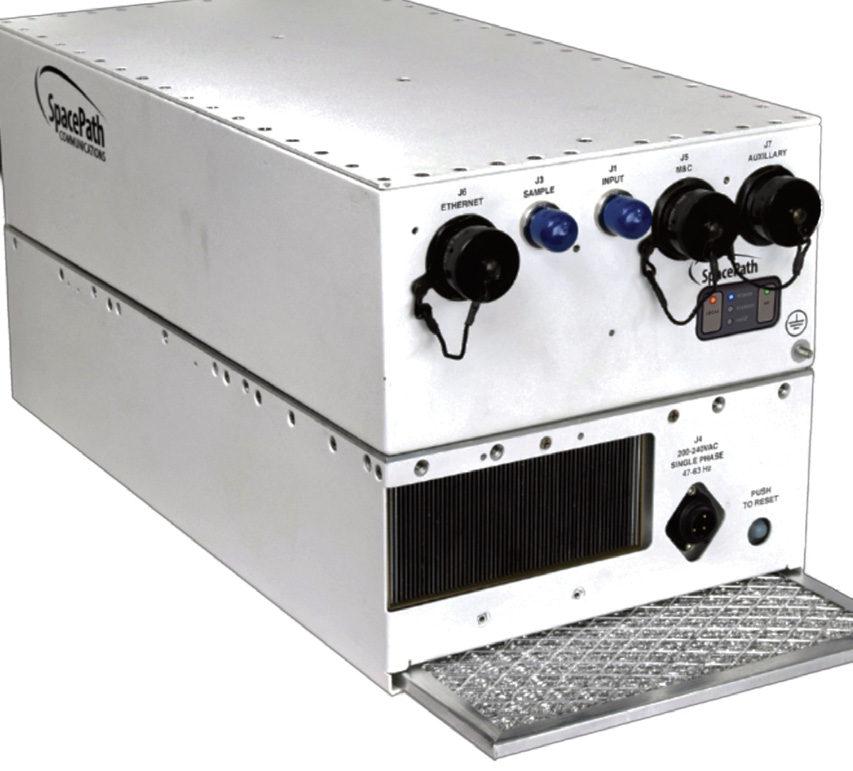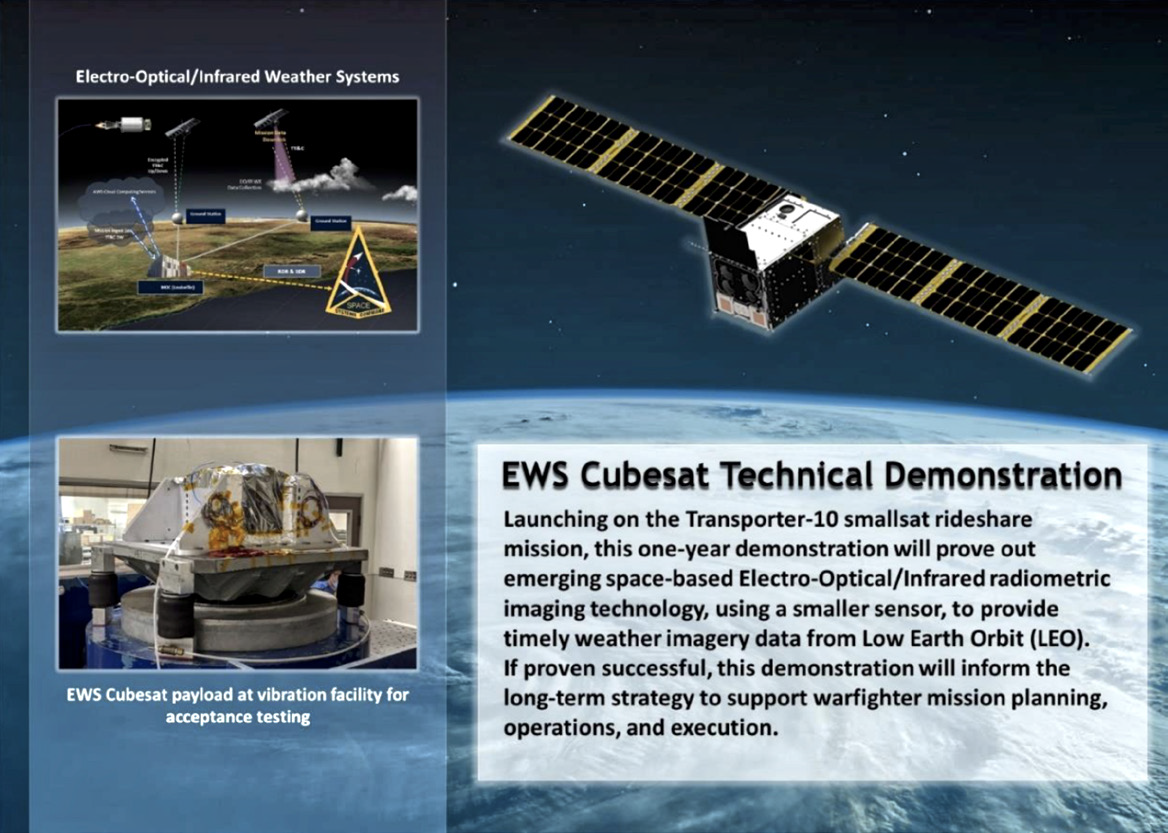General Atomics to provide missile tracking payloads for Lockheed Martin’s
SDA Tranche 2 Tracking Layer contract
General Atomics Electromagnetic Systems (GA-EMS) has been awarded a contract from Lockheed Martin Space to deliver missile warning, tracking and defense payloads to support the company’s recently announced contract award to deliver 18 satellites for the Space Development Agency’s (SDA) Tranche 2 Tracking Layer Program.
GA-EMS is developing the Electro Optical and Infrared (EO/IR) sensor systems that includes the 16 Wide-Field-of-View (WFOV) Missile Warning/Missile Tracking infrared payloads and two Fire Control/ Missile Defense (FC/MD) infrared payloads for integration into the Lockheed Martin satellites scheduled for launch in 2027.

GA-EMS’ missile warning/tracking payloads and fire control/missile defense payloads, which incorporate on-orbit mission data processing, deliver missile tracks in real-time and will be integrated onto the Lockheed Martin satellites. The satellites will be launched into LEO to be incorporated into SDA’s Proliferated Warfighter Space Architecture LEO constellation to provide persistent worldwide real-time missile detection and tracking capabilities.
“We are proud to be a part of Lockheed Martin Space’s team supporting the Tranche 2 Tracking Layer program mission,” said Scott Forney, president of GA-EMS. “We look forward to our payloads becoming an integral element of a satellite constellation providing significant military operational support for the detection and tracking of advanced and conventional missile threats, including hypersonic missile systems. The team’s Tranche 2 satellite solution represents a significant step forward in delivering real-time global missile warning, tracking, and defense capabilities to the warfighter.”
“GA-EMS’ dedicated optical sensor team specializes in the design and deployment of compact, high- performance, and affordable EO/IR sensor system solutions, that are ideally suited for this next- generation in missile tracking payloads,” said Dr. Steven Wein, senior director of GA-EMS Optical Sensor Systems. “Our in-house, end- to-end payload systems’ expertise is key to our ability to rapidly innovate and deliver these cost-effective, highly advanced solutions critical to our national security interests. The missile warning, tracking, and defense payloads add to our expanding portfolio of high-performance surveillance and sensing assets, including our compact, 16 spectral band EO/IR weather sensors for the U.S. Space Force’s EO/IR Weather System (EWS) satellite program.”
General Atomics Electromagnetic Systems (GA-EMS) Group is a global leader in the research, design, and manufacture of first-of- a-kind electromagnetic and power generation systems. GA-EMS’ history of research, development, and technology innovation has led to an expanding portfolio of specialized products and integrated system solutions supporting aviation, space systems and satellites, missile defense, power and energy, and processing and monitoring applications for defense, industrial, and commercial customers worldwide.
www.ga.com/ems
www.lockheedmartin.com/en-us/ capabilities/space.html
www.sda.mil/tracking/
Viasat selects Rocket Lab for LEO satellite services
Viasat’s selection of Rocket Lab USA, Inc (Nasdaq: RKLB) will support Viasat’s hybrid space communications networks demonstrations by producing a spacecraft bus and providing mission operation support.

The demonstrations will add to Viasat’s portfolio of multi-band, space-based relay communication services in support of Low Earth Orbit (LEO) space missions with substantial flexibility in managing data, with lower data latency and higher throughput in real time.
The partnership will bring Viasat, a global provider of satellite communications, and Rocket Lab USA, Inc (Nasdaq: RKLB), a launch and space systems company, together as part of Viasat’s work across two awards, totaling $80 million, under NASA’s Communications Services Project (CSP).
The project evaluates commercial satellite communications services and technologies to support NASA near- Earth communications requirements as it sunsets the Tracking and Data Relay Satellite System (TDRSS).
LEO satellites typically require direct line-of-sight to a ground station to communicate, introducing significant data latency into the mission operations.
Viasat’s Ka- and L-band relay solutions are designed to address this challenge with near real-time, low-data latency communications.


The Real-Time Space Relay (RTSR) space-qualified Ka-band terminal will use Viasat’s high-capacity Ka-band network of satellites in Geostationary Orbit (GEO) to enable LEO operators on-demand access to critical mission data.
The InCommand system will use Viasat’s global L-band network to provide real-time telemetry, tracking and command (TT&C) operations at any point in the spacecraft’s orbit.
Rocket Lab will also provide a new L-band radio for InCommand called Frontier, which will support demonstrations of various TT&C applications.
Scheduled to launch in early 2026, the demonstration mission will also include direct-to-ground communications through Viasat’s Real-Time Earth (RTE) Ground- Station-as-a-Service for S-, X-, and Ka-bands.
All transports will be integrated through Viasat’s Integrated Space Access Network (ISAN) to show the benefits of adaptable transport, giving LEO operators the ability to access data while balancing network availability, cost, and time- sensitive applications.
www.viasat.com
www.rocketlabusa.com
SpacePath debuts their new high-power 750W outdoor TWTA
SpacePath Communications (‘SpacePath’), a provider of high-performance satellite uplink amplifiers and associated equipment for the global SATCOM market, has developed a 750W traveling wave tube amplifier (TWTA), offering the highest power available in Ka-band.

SpacePath’s new STA-5575P-KA6ZN Ka- band amplifier offers 750W of peak power and is intended for military and high throughput satellite (HTS) applications and will benefit customers who need more power or extra margin in their links.
The amplifier’s innovative design also incorporates the company’s unique carbon fin air-cooling heat sink.
Offering similar thermal properties to copper, this cooling method allows the amplifier to be both smaller and lighter than comparable amplifiers as the carbon is approximately half the weight of equivalent cooling systems.
With users in mind, the amplifier is designed for cost-effective maintenance and convenience.

In addition to the lightweight cooling structure, the TWTA features removable and washable air intake filters, metric and imperial mounting threads and plug-n- play compatibility with competitive system interfaces.
Colin Bolton, Director of Business Development, SpacePath Communications, said, “Our new product roadmap is driven by our customers and understanding their requirements for higher levels of functionality and performance. As such, this third-generation amplifier features a combination of design innovation and superior performance to firmly meet future market demands.”
SpacePath’s high performance uplink amplifiers cover all mission-critical segments including HTS, mobile satellite, fixed-Earth stations and military satellite communications (MILSATCOM).
www.space-path.com/
Viasat’s first U.S. Navy MSC ship installation
Viasat, Inc. (NASDAQ: VSAT) has completed the first ship installation for the U.S. Navy Military Sealift Command (MSC) under the Next Generation Wideband (NGW) Follow-On (FO) 10- year, Indefinite Delivery/Indefinite Quantity (IDIQ) contract awarded to Inmarsat Government by the Defense Information Systems Agency (DISA) on June 30, 2022.

Under the contract, the company maintains and operates commercial communications infrastructure, which includes satellite systems, teleport services and terrestrial services. Inmarsat Government is now part of Viasat’s government business, following Viasat’s acquisition of Inmarsat on May 30, 2023.
This first installation of 105 ships demonstrates the company’s ability to deliver a robust, reliable global managed satellite communications (SATCOM) solution.
The company upgraded the MSC ship’s primary afloat network from Ku-band to the Global Xpress (GX) Ka-band system and ELERA Enhanced L-band Maritime Antenna (ELMA), a variant of the award- winning, LAISR L-band solution to provide communications on the move via a small- size, high throughput terminal.
The hybrid solution of Ka- and L-band service ensures that the MSC ships have secure, resilient, worldwide communications capabilities, as well as a reliable global, on- demand backup network.
This approach is designed to provide significant enhancements over legacy Ku-band by providing higher and scalable data rates on ships’ primary and back-up systems, and uniform coverage across the GX and ELERA networks.
Additionally, by delivering the primary and secondary SATCOM capabilities in a holistic, managed service model that includes satellites, ground networks and type- approved terminals — SATCOM as a Service.
The MSC fleet benefits from an integrated, worldwide solution that delivers high throughput with RF (Radio Frequency) band and path diversity to ships at sea.
All of the network aspects are designed as a single solution and for mobility, so users experience a reliable, on-demand continuous service.
“The Military Sealift Command plays a critical role in our nation’s defense. Our ships must have resilient communications capabilities that deliver consistent performance and can be relied upon regardless of location or weather conditions,” said Eliot J. Skinner, Deputy Command Information Officer. “These upgrades ensure that our Mariners can confidently operate anywhere in the world knowing they have a reliable, redundant communications network supporting them.”
“We have reliably served the U.S. Navy Military Sealift Command for more than 10 years, and we are proud to continue supporting its operations around the world,” said Steve Gizinski, Managing Director, Viasat Government Services. “These upgrades provide the MSC fleet with significant enhancements in COM capabilities.
Space Systems Command EWS tech demo smallsat is launched
Space Systems Command successfully launched the organization’s Electro- Optical/Infrared (EO/IR) Weather Systems (EWS) cubesat technical demonstration onboard the SpaceX Transporter-6 mission at 9:56 a.m. (Eastern, 6:56 a.m. Pacific) from Cape Canaveral Space Force Station, Florida on January 3, 2023.

This one-year EWS cubesat tech demo will prove out emerging, space-based, EO/IR radiometric imaging technology, using a smaller sensor to provide timely weather imagery data from LEO.
In February of 2002, the EWS program competitively selected two vendors to develop and launch two separate, sensor prototypes.
Orion Space Solutions, a non-traditional government contractor, delivered the cubesat for this demonstration. General Atomics Electromagnetic Systems Group will deliver the second prototype by 2025.
This launch satisfies the FY20 National Defense Authorization Act (NDAA) Congressional mandate to launch a weather EO/IR pathfinder prototype by FY23. The program expects the first transmittal of data early in 2023.
“The EWS cubesat technical demonstration effort represents SSC’s continued commitment to working with non-traditional partners to broaden the competitive industrial base. If successful, this will provide an innovative option to deliver Space-Based Environmental Monitoring data to the warfighter at an operationally relevant speed,” said Lt. Col. Joe Maguadog, EWS Materiel Leader and Program Manager. “This demonstration will inform our transition toward a more affordable, scalable, and resili nt EO/IR weather constellation.”



